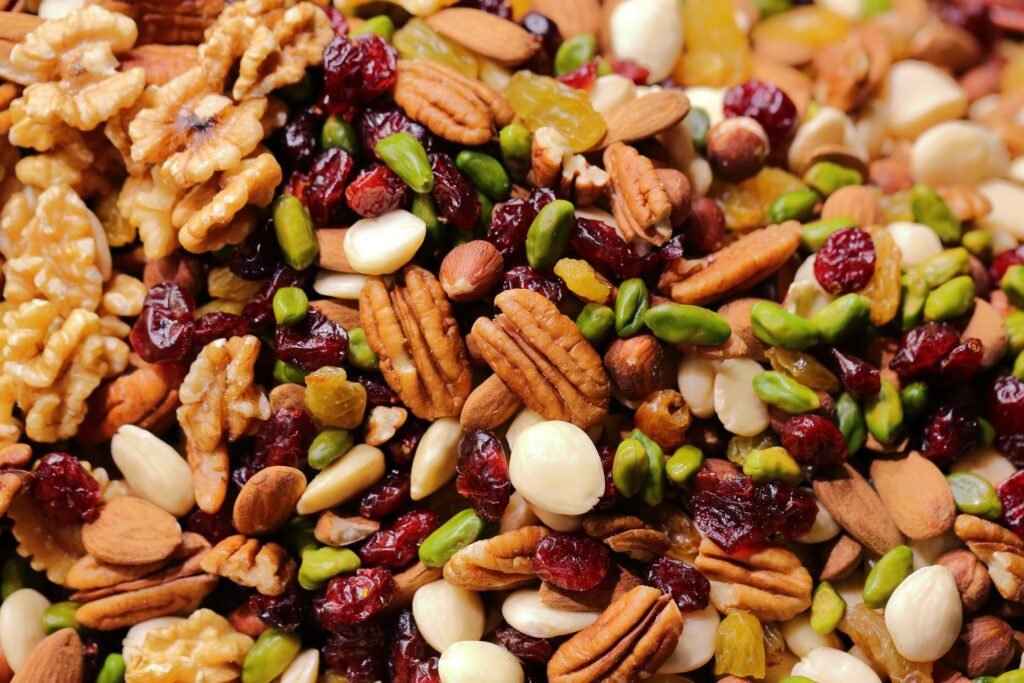Fiber up! Discover 4 reasons why
Did You Know?
Fiber is a type of carbohydrate that the body cannot digest in the stomach. While most carbs are broken down into simple sugars and utilized by the body, fiber is indigestible and produces the most benefits in the process of passing through the body. Fiber also comes in 2 forms: soluble and insoluble fiber to help regulate cholesterol and blood sugar and improve bowel regularity. The best sources of both types come from whole wheat grains, fruits, vegetables, and nuts. It is important to eat from a variety of high-fiber sources to get the most health benefits. Soluble fiber, a type of fiber that dissolves in water is found in oats, peas, apples, and carrots and is responsible for balancing blood glucose and cholesterol. While insoluble fiber, which does not dissolve in water and comes from nuts, potatoes, and green veggies is responsible for regulating bowel movements and relieving constipation. Overall, both help promote the movement of waste through the colon by regulating the water content so the stool can be easier to eliminate. Even though gut health is one of fiber’s biggest benefits, continue reading to discover 4 additional benefits of fiber for you.

4 Benefits of Fiber
1. Helps reduce the risk of chronic disease
Fiber is responsible for helping decrease cholesterol, which is an indicator of the risk of developing heart disease. Studies have been able to prove that soluble fiber can help decrease LDL cholesterol (bad cholesterol). There has not been a reported effect on HDL (good cholesterol), which is okay because this can be increased through healthy eating.
2. Helps maintain a healthy gut
Maintaining a healthy gut is one of fiber’s biggest benefits. It helps promote regularity by affecting the water content in the stool. This is important because if the stool is too dry, this results in constipation and if it is too runny, it results in diarrhea. Therefore, fiber helps adjust the stool content by making it bulkier, which is easier to pass.

3. Help you lose weight
Fiber can help with weight loss because high fiber foods are more filling and so prevent overeating and overindulgence. The journey to trying to lose weight can be difficult and consistently feeling hungry may interfere with your goals. Therefore, including more fibrous foods is a great way to ensure you get adequate nutrition and feel satisfied.
4. Help control blood sugar
Fiber can help control blood sugar in people at risk of developing type 2 diabetes, which is a disease that can be modified through lifestyle habit changes. One study was able to associate a diet high in whole grains with reduced risk for type 2 diabetes and for this reason, researchers concluded the superiority of a high fiber diet.

What Should You Do About It?
First, talk to your doctor. Especially if you have a certain medical history of GI issues. IBD flare-ups are a delicate time for your intestinal tract, and it is recommended to avoid indigestible fiber foods as they can continue to trigger inflammation. Therefore, talk to your doctor or dietician before changing your diet or adjusting your foods.
The daily recommendation of fiber for adults 50 or younger is 38grams for men and 25 grams for women. The recommendation for adults 50 or older is 30grams for men and 21grams for women. As we age, the GI system naturally slows down so it becomes even more important to reach that limit and prevent episodes of constipation (which is common in older adults).

How To Make It SMART
SHORT- Include more fiber into your diet in the form of whole grains, fruits, and veggies. Mayo Clinic recommends eating whole foods instead of using fiber supplements because supplements won’t provide the vitamins and minerals that fresh veggies and fruits will. One great way to include fiber is at the beginning of the day with breakfast, so for example, choose a high-fiber cereal and a piece of fruit
MEASURABLE- Fiber is an overall benefit to maintaining a healthy lifestyle. However, take note of your bowel movements and assess whether you are having more regularity, which is the biggest benefit of fiber. Beware of adding too much fiber at once because this can result in gas, bloating, or cramping. Increase your fiber slowly so your gut can adjust and drink plenty of water so the fiber can work best
Read here about 4 reasons why you should drink more water
ATTAINABLE- Is this something you want to implement consistently? You should aim to include fiber into your diet for overall health because it is an important part of your daily nutritional intake. Additionally, your immune system is affected by your gut microbiome, so a healthy gut is a healthier you
REASONABLE- Is it possible to implement? Adding fiber to your diet can be easily implemented when you begin your day with a fibrous meal. If you eat oatmeal and a banana for breakfast, that accounts for 8grams of fiber. Later for lunch, you can also choose an even higher fiber food like split peas or lentils, which have up to 16grams of fiber. This will make it easy to reach the recommended daily intake
TIMELY- Commit to consuming the recommended amount of daily fiber for 30-60 days and assess how you feel. You may feel fuller and more satisfied with your meals and have improved GI regularity
As always,
Love yourself in health, one day at a time

